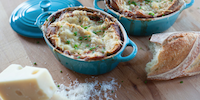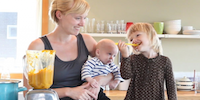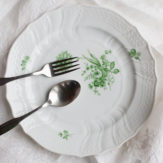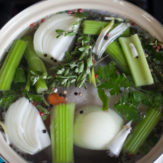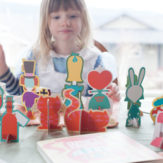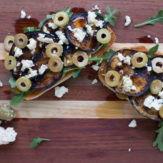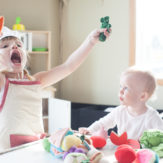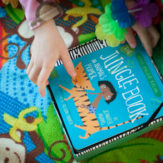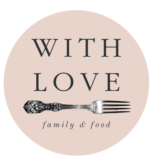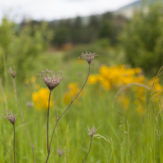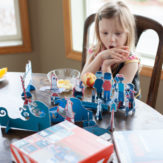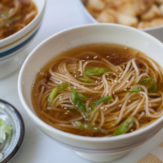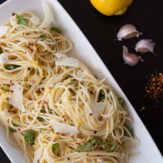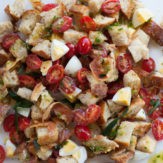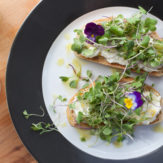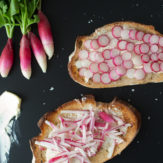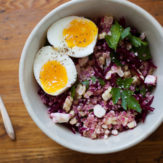When I was a little, we spent every Christmas Day at my Grandma and Grandpa’s house. My Grandparents’ house was always warm and cozy, and always smelled slightly smokey due to the firelplace and woodfire stove. The house seemed huge to me, the Christmas tree was always over-lit with hundreds of white lights. My Grandma made Christmas elegant; she was an elegant lady. Their little kitchen island always boasted an array of snacks and treats… Almond Roca, my Grandma’s caramels, cookies from Grandpa’s favorite bakery. Come to think of it, I’m sure there were savory snacks as well but I inherited my Grandpa’s sweet tooth so I only had eyes for things dusted with powdered sugar.
There was always a nice Christmas dinner, usually consisting of a roast (expect for when I was a vegetarian and my well-intentioned Grandma made a ham, “Honey, I know you don’t eat meat so I made you a ham.”), a green salad with Grandma’s ketchup-and-vinegar dressing, and various classic sides. Dinner was lovely but I couldn’t wait for dessert, more specifically for Grandpa’s “famous” apple pie.
Grandpa’s pie was tart and sweet, with apples sliced so thinly they practically melted in your mouth. Their oven was old, electric, and very small, and the bottom of his pies were always coated with a thin crust of caramel, something I haven’t been able to replicate despite years of trying. His crust is rolled so thin you can see through it, using only one pie crust recipe for two pies. My Grandpa just turned 92 and he still sends me recipes, and we talk about all things baking: crusts, pies, tarts… he is my favorite resource.
When I was a teenager, I called him and asked him if he would teach me how to make his spectacular pies. He obliged and we spent a day in the kitchen together. Everything my Grandpa does is done with precision. He was methodical and specific. He peeled the apples with a small paring knife, the slices were 2mm thick, the flour sifted perfectly. His pies were not glamorous, the tops were often patched up, with perfunctory vents. He used a fork to crimp the edges, then rolled the sides in to prevent the juices from making a mess in the oven. Practicality trumps beauty in his book… which is ironic since my Grandma was just the opposite.
I remember thinking that I would never be able to make them quite as good as he does, and I think that’s true, but I love making them nonetheless. I love this time of year when I can go to the store and load up on apples, and set about baking pies. Gigi is now old enough to (kind of) help me make them. We recently pulled on our aprons and got down to business making Great Grandpa’s Apple Pies. It means so much to me to be making them with Gigi, even if she’s mostly just making a mess.
 PIN
PIN
 PIN
PIN
 PIN
PIN
 PIN
PIN
 PIN
PIN
 PIN
PIN
 PIN
PIN
GREAT GRANDPA’S APPLE PIE
Ingredients for Pie Crust.
1 1/3 cup cake flour
1 cup all-purpose flour, plus more for rolling surface
1 stick very cold butter, cut into slices
1 tsp fine salt
ice water
Ingredients for Pie Filling.
3 1/2 lbs Granny Smith Apples, once peeled and cored you should have about 2lbs
1 -1 1/3 cup sugar, depending on tartness of apples
1/4 cup lemon juice, freshly squeezed
1 tsp ground nutmeg
1-2 tsp ground cinnamon, depending on how much spice you prefer
1 tbsp butter
2 tbsp all-purpose flour
1 tbsp milk
Directions.
First, peel and core the apples, then set them aside in a large bowl of water to keep them from browning.
To make the crust, place the cake flour, all-purpose flour, and salt in a food processor. Pulse to combine. Scatter in the slices of butter, then pulse again until the butter is well combined. Slowly, with the food processor running, drizzle in the ice water. You want to take your time adding a little water at a time until the dough just forms a ball. Transfer the dough to a ziploc bag and set in the fridge while you slice the apples.
Drain the water from the bowl holding the apples. Using a 2mm or 4mm blade (the standard size that comes with most food processors is 4mm) slice all of the apples, in batches if necessary. Return the apples to the large bowl, toss with the lemon juice.
Preheat your oven to 450º F.
Sprinkle 1 teaspoon of sugar into the bottom of your pie dish. Remove your dough from the fridge. Separate 1/3 of the dough and put it back in the bag, and set aside. Working with 2/3 of the dough, roll it into a ball, on a well floured surface, roll out the dough until it will fit your pie pan, or it reaches your desired thickness. I prefer mine really thin. Transfer the bottom crust to your pie dish. Use a fork to poke a few holes in the bottom pie crust.
Start assembling your pie filling by evenly distributing the following in layers:
2/3 cup sugar
1/3 of the nutmeg and cinnamon
sift
1 tbsp flour to cover the cinnamon
1/2 of the sliced apples, take your time and pack them in as tightly as you can
1/3 cup sugar
1/3 of the nutmeg and cinnamon
sift 1 tbsp flour to cover the cinnamon
the rest of the apples
the rest of the nutmeg and cinnamon
dot with 1 tbsp butter
Form the remaining 1/3 of your pie dough into a ball. Working on a floured surface, roll out the top crust.
Using your fingertip, dab milk around the outside rim of the bottom pie crust before transferring the top crust to the pie. Press to seal the edges, trim the excess crust, and use a fork or crimp to finish the edges.
Use a sharp knife to cut vents in the top crust, creating whatever kid of design you like.
Place the pie on a baking sheet bake in the center of the oven at 450ºF for 15 mins, reduce heat to 350ºF for another 25-35mins, until the apples have no resistance when a skewer is inserted through one of the air vents.
Transfer the pie to a wire rack, allow it to cool for 1 hour before serving it with vanilla ice cream, or fresh whipped cream.
PRINTABLE RECIPE.
GREAT GRANDPA’S APPLE PIE
.jpg)
.jpg)
.jpg)




.png)
